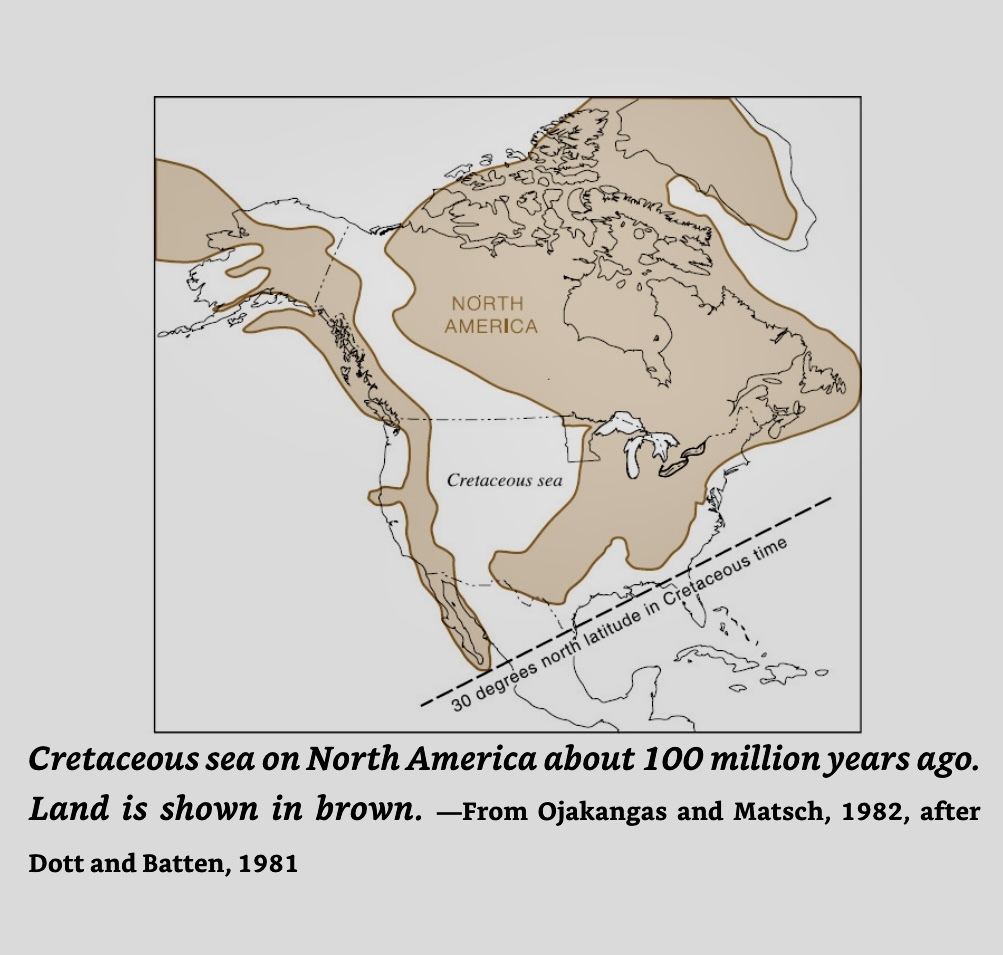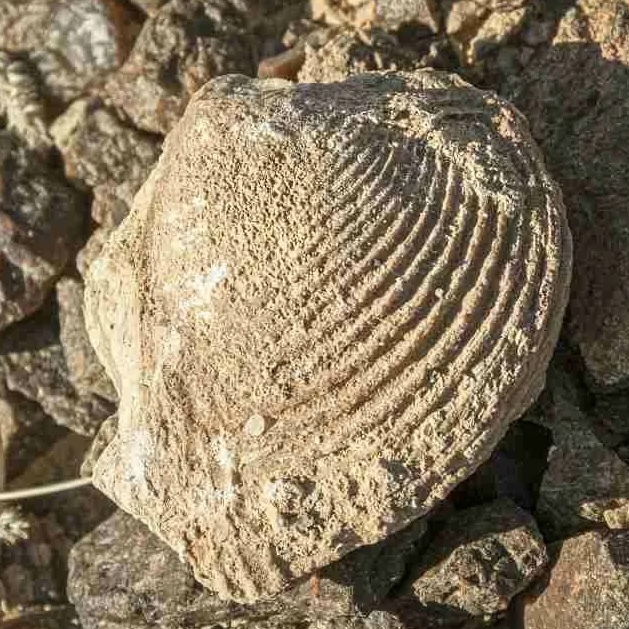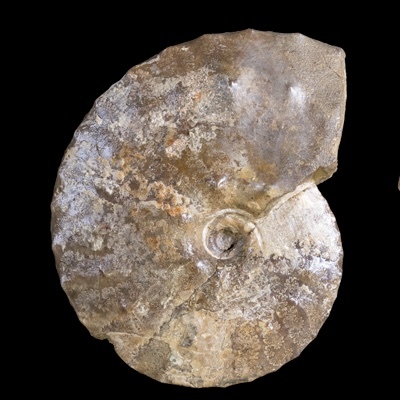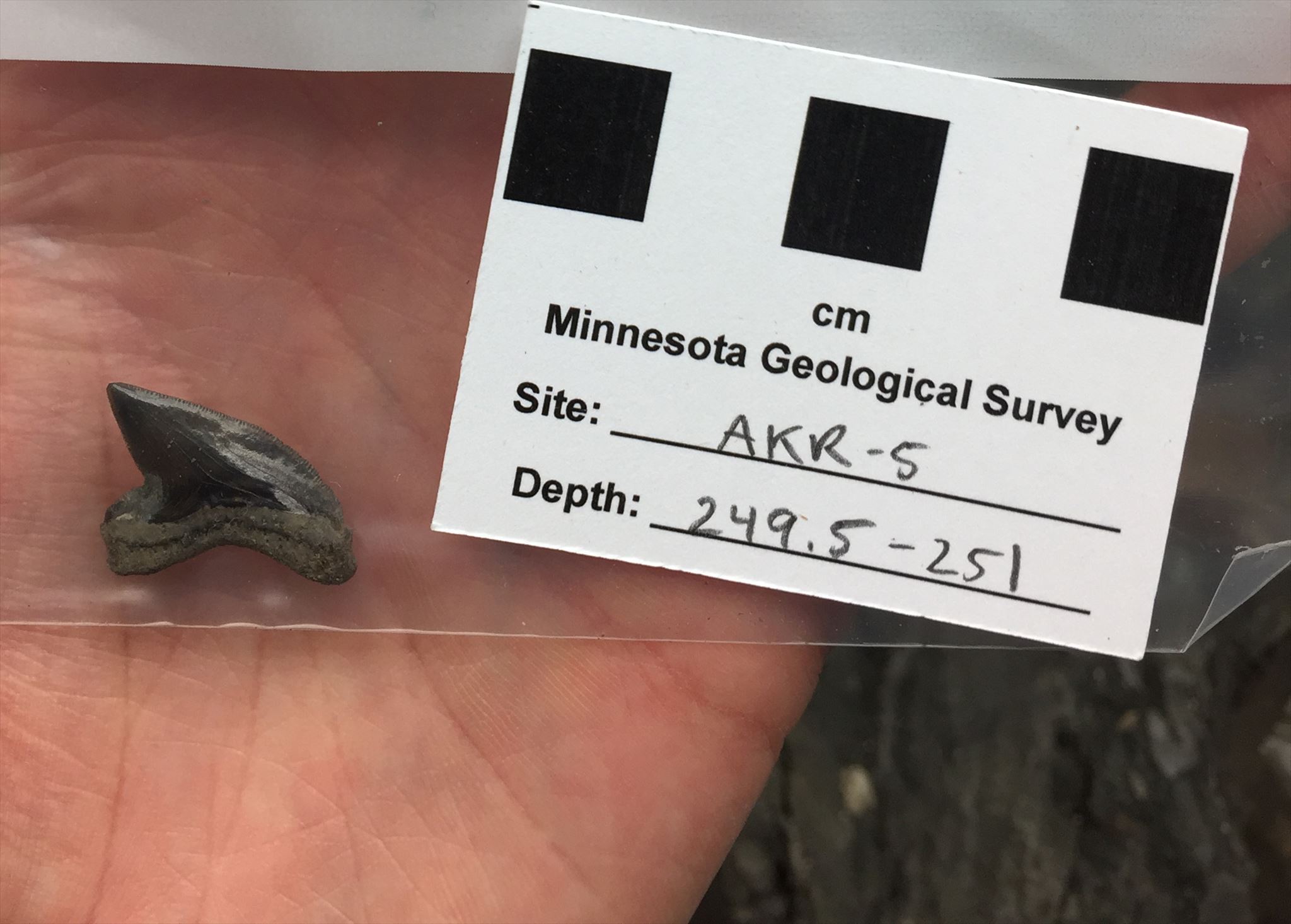This Earthcache has three stages, all of which were placed with permission from the Minneapolis-Saint Paul International Airport. The first stage (posted coordinates) is located in the valet parking lobby, outside the secure area and is accessible to everyone. The other two stages are in MSP Airport, accessible only to airport employees or travelers with a valid boarding pass. ONLY ONE STAGE is required to claim the find, however you may visit all three if you wish. I want this Earthcache to be fun and educational! As you transit through the airport, observe the stone tiles on the floor and on some of the walls. What are those interesting shapes that you see throughout?
Minnessota is known as "The Land of 10,000 Lakes" but during the Cretaceous period, which occurred 145 to 65 million years ago, an inland sea covered the midwestern United States. The Western Interior Seaway extended from the Gulf Coast all the way into Western Minnesota, up through Canada and into the Arctic Ocean. At its widest, it extended all the way from the present-day Rocky Mountains east to the Appalachians. As far as seas are concerned, The Western Interior Seaway was shallow, perhaps 2600 to 3000 feet deep.[1] As the climate was much warmer then, this sea was host to abundant life. Ammonites, clams, corals, oysters and even sharks lived in The Western Interior Seaway during the Cretaceous period. As these creatures died off, their remains settled at the bottom of the sea floor and were quickly buried by sand, mud or other sediment. During sedimentation the soft parts of the animals were destroyed by bacteria, leaving only the hard parts such as teeth, shells and bones. Over time, these sediments were compressed into rock. Fossils are literally the remains of plants and animals found in rock. Fossilized snails, clams, oysters and shark teeth can be found in north central Minnesota dating to 100 million years ago (the Cretaceous Period).[2]

Roadside Geology of Minnesota by Richard W. Ojakangas, p. 451.
Examples of Cretaceous fossils that can be found in Minnesota include, but are not limited to:
1. Clams (Bivalves)
As the name suggests, these creatures are characterized by their two shells of the same size connected to each other. Like their modern-day relatives, these ancient filter feeders lived in muddy sediment on the seabed and moved around on a fleshy foot.[3] Freshwater clams are abundant in Minnesota lakes today.

Fossilized clam found at Cretaceous Ore Pile in Hill Annex Mine State Park. https://www.lifeinminnesota.com/hill-annex-mine-state-park/
2. Ammonites (Cephalopods)
Ammonites are an extinct group of marine animals belonging to the cephalopod subclass Ammonoidea. From the Devonian until Late Cretaceous (417 - 65 million years ago), ammonites lived in Minnesota and all over the world. They became extinct around the same time as the dinosaurs.[4] Like their modern-day counterparts (octopuses, squid and cuttlefish), ammonites were able to propel themselves through the water and used their tentacles to catch their prey.[5] Most ammonite fossils are characterized by their spiral shape, called a planisphere, although some non-spiral forms have been found.[6]

Cretaceous ammonite. https://www.cretaceousatlas.org/species/placenticeras-adkinsi/
3. Shark Teeth
The presence of fossilized shark teeth and other fish parts in Cretaceous sediments are further evidence that The Western Interior Seaway was warm and shallow.[7] Like modern-day sharks, Cretaceous sharks continually shed their teeth, and because of the hardiness of that material, their teeth and those of other fish were more readily fossilized and preserved than other softer material.[8.]

Fossil shark tooth, genus Squalicorax, from Cretaceous bedrock drill core in Aitkin County. Photo courtesy of Andrew J. Retzler. https://cse.umn.edu/mgs/fossils
4. Anthozoans (Corals)
Anthozoa is a class of marine invertebrates which includes the sea anemones, stony corals and soft corals. Adult anthozoans are almost all attached to the seabed, while their larvae can disperse as part of the plankton.[9] Like their modern counterparts, prehistoric corals were simple animals that fed by capturing small floating sea life with their tentacles. Some types were colonial, meaning many animals lived together in one skeleton and others were solitary. Many of the corals that lived during prehistory have modern descendants. Others, such as horn corals are extinct.[10]

Scleractinian (stony) coral found in Minnesota near the Minnesota River. Coral ID - Fossil ID - The Fossil Forum
References:
1. https://en.wikipedia.org/wiki/Western_Interior_Seaway
2. Fossils - clues to the past | Minnesota DNR (state.mn.us)
3, 5, 7, 10. https://cse.umn.edu/mgs/fossils
4. https://www.geologyin.com/2019/05/the-largest-ammonite-ever-found.html
6. https://en.wikipedia.org/wiki/Ammonoidea
8. The Roadside Geology of Minnesota by Richard W. Ojakangas, p. 450-451.
9. Anthozoa - Wikipedia
To claim this Earthcache, you only need to visit ONE waypoint and answer the questions relating to that particular waypoint.
Waypoint 1 (Valet Parking Lobby, Pre-Security, posted coordinates)
N 44° 52.990 W 093° 12.663
1. In the lobby for valet parking, face the elevators with the mosaic behind you. In the tile on the wall to the right, just before the stairs you will see a beautiful, fossilized example of the many sea creatures that thrived in Cretaceous Minnesota. What kind of fossil is it?
2. How many of these fossils do you see in this tile?
3. On the opposite wall near the doors is a silver plaque with information about the mosaics. What is the title of the mosaics and who is the artist?
4. Post a photo of you (face not required) or a personal item with the mosaic in the background.
----
Waypoint 2 (inside main concourse, next to the Snoopy statue):
N 44° 53.002 W 093° 12.705
GZ is located at the Snoopy statue and to his right.
1. Based on your observation and the examples listed on the cache page, what type of fossil do you see in the tile?
2. Do you notice any distinguishing characteristics that would differentiate this fossil from others? Describe those characteristics.
3. On Snoopy's left side, what type of fossil is in the tile there? At its widest point, how many inches across is it?
4. Post a photo of you (face not required) or a personal item near GZ without revealing any spoilers.
More information about the Snoopy statue can be found here:
Snoopy The North Star Flying Ace from the collection of Arts@MSP | Artwork Archive
----
Waypoint 3 (Concourse C Art Gallery):
N 44° 53.000 W 093° 12.433
1. Based on the cache description, what are fossils and how are they made?
2. What type of fossil do you see in the tile on the wall?
3. How many inches across is it?
4. Do you see any other fossils in the tiles along the wall?
5. At GZ there is an object on the wall that is not a fossil. What is it?
6. Post a photo of you (face not required), or a personal item with the artwork in the background.